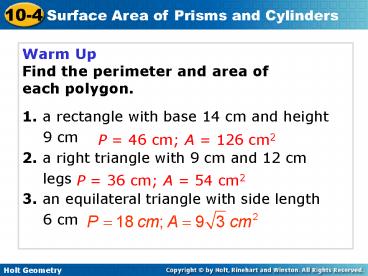Warm Up - PowerPoint PPT Presentation
Title: Warm Up
1
Warm Up Find the perimeter and area of each
polygon. 1. a rectangle with base 14 cm and
height 9 cm 2. a right triangle with 9 cm and 12
cm legs 3. an equilateral triangle with side
length 6 cm
P 46 cm A 126 cm2
P 36 cm A 54 cm2
2
Objectives
Learn and apply the formula for the surface area
of a prism. Learn and apply the formula for the
surface area of a cylinder.
3
- Prisms and cylinders have 2 congruent parallel
bases. - A lateral face is not a base.
- The edges of the base are called base edges.
- A lateral edge is not an edge of a base.
- The lateral faces of a right prism are all
rectangles. - An oblique prism has at least one nonrectangular
lateral face.
4
An altitude of a prism or cylinder is a
perpendicular segment joining the planes of the
bases. The height of a three-dimensional figure
is the length of an altitude.
- Surface area is the total area of all faces and
curved - surfaces of a three-dimensional figure.
- The lateral area of a prism is the sum of the
areas of the lateral faces.
5
The surface area of a right rectangular prism
with length l, width w, and height h can be
written as S 2lw 2wh 2lh.
6
Example 1A Finding Lateral Areas and Surface
Areas of Prisms
Find the lateral area and surface area of the
right rectangular prism. Round to the nearest
tenth, if necessary.
L Ph
P 2(9) 2(7) 32 ft
32(14) 448 ft2
S Ph 2B
448 2(7)(9) 574 ft2
7
Check It Out! Example 1
Find the lateral area and surface area of a cube
with edge length 8 cm.
L Ph
32(8) 256 cm2
P 4(8) 32 cm
S Ph 2B
256 2(8)(8) 384 cm2
8
- The lateral surface of a cylinder is the curved
surface that connects the two bases. - The axis of a cylinder is the segment with
endpoints at the centers of the bases. - The axis of a right cylinder is perpendicular to
its bases. - The axis of an oblique cylinder is not
perpendicular to its bases. - The altitude of a right cylinder is the same
length as the axis.
9
(No Transcript)
10
Example 2A Finding Lateral Areas and Surface
Areas of Right Cylinders
Find the lateral area and surface area of the
right cylinder. Give your answers in terms of ?.
The radius is half the diameter, or 8 ft.
L 2?rh 2?(8)(10) 160? in2
S L 2?r2 160? 2?(8)2 288? in2
11
Check It Out! Example 2
Find the lateral area and surface area of a
cylinder with a base area of 49? and a height
that is 2 times the radius.
Step 1 Use the circumference to find the radius.
A ?r2
Area of a circle
49? ?r2
Substitute 49? for A.
Divide both sides by ? and take the square root.
r 7
12
Check It Out! Example 2 Continued
Find the lateral area and surface area of a
cylinder with a base area of 49? and a height
that is 2 times the radius.
Step 2 Use the radius to find the lateral area
and surface area. The height is twice the radius,
or 14 cm.
Lateral area
L 2?rh 2?(7)(14)196? in2
Surface area
S L 2?r2 196? 2?(7)2 294? in2
13
Example 3 Finding Surface Areas of Composite
Three-Dimensional Figures
Find the surface area of the composite figure.
14
Example 3 Continued
The surface area of the rectangular prism is
.
.
Two copies of the rectangular prism base are
removed. The area of the base is B 2(4) 8 cm2.
15
Example 3 Continued
The surface area of the composite figure is the
sum of the areas of all surfaces on the exterior
of the figure.
S (rectangular prism surface area)
(triangular prism surface area) 2(rectangular
prism base area)
S 52 36 2(8) 72 cm2
16
Example 4 Exploring Effects of Changing
Dimensions
The edge length of the cube is tripled. Describe
the effect on the surface area.
17
Example 4 Continued
original dimensions
edge length tripled
S 6l2
S 6l2
6(24)2 3456 cm2
6(8)2 384 cm2
Notice than 3456 9(384). If the length, width,
and height are tripled, the surface area is
multiplied by 32, or 9.
18
Check It Out! Example 5
A piece of ice shaped like a 5 cm by 5 cm by 1 cm
rectangular prism has approximately the same
volume as the pieces below. Compare the surface
areas. Which will melt faster?
The 5 cm by 5 cm by 1 cm prism has a surface area
of 70 cm2, which is greater than the 2 cm by 3 cm
by 4 cm prism and about the same as the half
cylinder. It will melt at about the same rate as
the half cylinder.
19
Lesson Quiz Part I
Find the lateral area and the surface area of
each figure. Round to the nearest tenth, if
necessary. 1. a cube with edge length 10 cm 2.
a regular hexagonal prism with height 15 in. and
base edge length 8 in. 3. a right cylinder with
base area 144? cm2 and a height that is the
radius
L 400 cm2 S 600 cm2
L 720 in2 S ? 1052.6 in2
L ? 301.6 cm2 S 1206.4 cm2
20
Lesson Quiz Part II
4. A cube has edge length 12 cm. If the edge
length of the cube is doubled, what happens to
the surface area? 5. Find the surface area of
the composite figure.
The surface area is multiplied by 4.
S 3752 m2
21
Homework
- Worksheet 10-4

